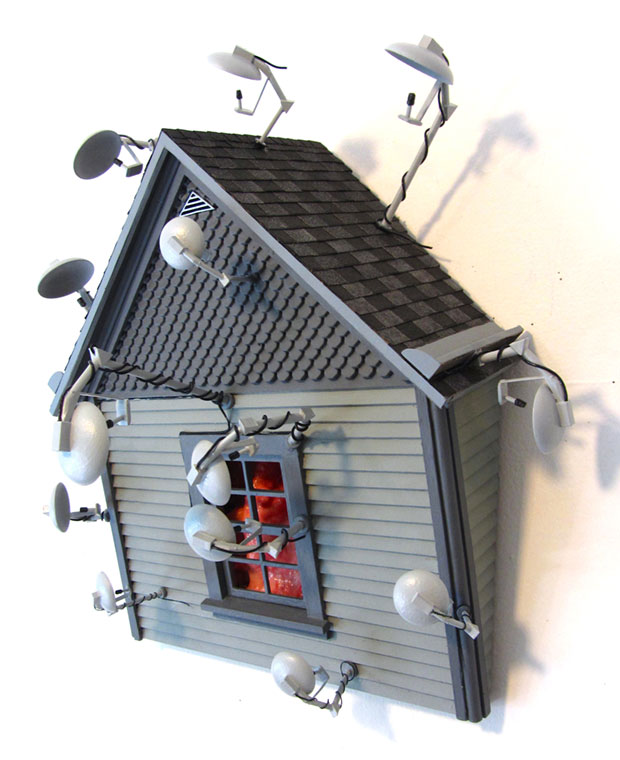Unknown Knowns: Gary Sczerbaniewicz at BT&C Gallery
Artist Gary Sczerbaniewicz is big into theory. Some of it pretty exotic. Pretty esoteric. But the overall conceptual framework—and ultimate message—of his work currently on show at the BT&C Gallery seems pretty straightforward. In a basically theory sort of way still. With consistent reference to deconstruction, the theoretical tsunami that washed over the literary and visual and all other art worlds a few decades back. As aesthetic principle, but even more notably in this work political phenomenon. In global terms. The cause and origin of which global deconstruction was the disastrous presidency of George W. Bush. The lies and chicanery in promoting the Iraq War, the imbecile follow-up decisions, the legacy Islamic State.
A piece called Paul Bremer—the Bush administration man in Iraq in the war aftermath, the guy in the business suit and combat boots who made or implemented most of the imbecile decisions—is a literal building deconstruction site, a brick outer wall with limp phallic tube of interlocking conical cylinders—of the sort to convey building interior demolition scrap to a dumpster or truck below for transportation to a landfill—attached to a portal window.
Another piece, called I., L.ewis L.ibby, in reference to the Bush administration figure who was tried and convicted of a slew of charges related to the vindictive outing of two covert government operatives—taking the fall for his boss, V.P. Dick Cheney—is a kind of open-top trash incinerator, with infernal overtones.
The show centerpiece—a large free-standing floor work—is called Tunguska Minor, in reference to a mysterious possibly astronomical event in the early twentieth century in Siberia that left what the artist calls “an apocalyptic wasteland” thousands of square miles in area. The focal aspect of the piece is approached via several steps up, then rather hard-to-negotiate rampway down—Sczerbaniewicz likes to put his audience through some physical exertions in accessing his work, maybe on the idea that pain equals gain, but at least to make it a bit of a visceral experience—whereupon you peer into a sort of diorama viewing channel at a domestic interior space crash-destroyed by some unknown cataclysmic occurrence. What was a living room floor now a huge open hole, looking into another infernal scene below. And broken frame and shattered glass picture of George W. Bush hanging askew on one of the still intact walls.

In some artist’s statement bits and pieces (somewhat veering into theory talk), Szcerbaniewicz notes his “compulsion toward an aesthetics of anxiety,” and how he is “drawn to create works in which some unknown, sudden event has rendered a space inert, transforming it from its original intended function into some sort of hybrid and liminal zone. In many of the works in this exhibit, it is evident that some violent upheaval has occurred, revealing a latent and Otherly substance which is incompatible and in conflict with its host body.”
Wall text commentary on the Tunguska Minor piece talks about a traumatic event scene of unclear origin and the impulse to discover its origin. Sometimes this impulse is interpreted in specifically archeological—or paleontological—terms. Artwork as literally digging into the past. A piece called Archaeopteryx. Which is also a building deconstruction scene of sorts. An empty brick wall marked indicating where a stairway used to be situated set against the wall.
The title of the show is Unknown Knowns, a conceptual—or maybe better non-conceptual—category Bush administration Secretary of Defense Donald Rumsfeld brought to the general attention in describing some of the matters we were getting into in the Iraq War. His definition: “Things that we don’t know that we don’t know.” (A rather prescient description of the whole war, as it has turned out.)
To Rumsfeld’s definition, the artist opposes one by philosopher and cultural critic and theorist Slavoj Zizek: “Things that we don’t know that we know…things that we know, that are part of our identity, but we don’t know that we know them…but that determine our behavior.” Zizek adds: “What you don’t know that you know controls you, but you don’t control it.”
So personal as well as political issues under deconstruction here, it seems. Like maybe religious upbringing issues. That trauma event. In the visual imagery—the prevalent hell fires—and some of the textual imagery. In the Archaeopteryx commentary, in a revealing aside, the artist talks about a past golden age. In actuality, there never was a golden age. It’s a story, a myth. In many myth versions, but none more prominent than in the Book of Genesis.
This interesting exhibit by this interesting artist continues through July 30.
Unknown Knowns
BT&C Gallery / 1250 Niagara St, Buffalo / btandcgallery.com
